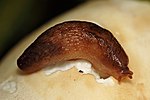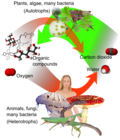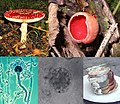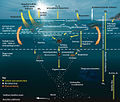 | Myco-heterotrophy (from Greek μύκης mykes, "fungus", ἕτερος heteros, "another", "different" and τροφή trophe, "nutrition") is a symbiotic relationship... 16 KB (1,531 words) - 19:18, 8 November 2023 |
mycotrophic in this sense. Examples include Burmanniaceae. Some mycotrophs are parasitic upon fungi in an association known as myco-heterotrophy. v t e... 968 bytes (82 words) - 18:32, 20 August 2023 |
 | produce and instead gain sugars from the fungi, a process called myco-heterotrophy. Some plants are only dependent on fungi as a source of sugars during... 31 KB (3,724 words) - 06:48, 29 April 2024 |
Mycoparasitism (section Myco-heterotrophy) Monotropa uniflora. Mycoparasitic plants are more precisely described as myco-heterotrophs. Some bacteria live on or within fungal cells as parasites or... 14 KB (1,394 words) - 15:50, 25 September 2023 |
 | Corallorhiza (category Myco-heterotrophic orchids) coral-shaped rhizomes for sustenance. Because of this dependence on myco-heterotrophy, they have never been successfully cultivated. Most species are leafless... 5 KB (287 words) - 01:25, 2 January 2023 |
Chemosynthesis Chemotrophs Foundation species Kinetotrophs Mixotrophs Myco-heterotrophy Mycotroph Organotrophs Photoheterotrophs Photosynthesis Photosynthetic... 22 KB (2,260 words) - 05:17, 30 April 2024 |
 | Heterotroph (redirect from Heterotrophy) except for myco-heterotrophic plants. Lastly, Domain Archaea varies immensely in metabolic functions and contains many methods of heterotrophy. Autotroph... 27 KB (2,935 words) - 20:11, 6 April 2024 |
 | S2CID 259078590. Merckx VSFT; Bidartondo MI; Hynson NA. (2009). "Myco-heterotrophy: When fungi host plants" (PDF). Annals of Botany. 104 (7): 1255–1261... 19 KB (1,915 words) - 10:32, 11 January 2024 |
contributor. In the early issues Luxford wrote a series of ten articles on myco-heterotrophy, around Monotropa hypopithys, and prompted sharp debate. James Backhouse... 7 KB (1,151 words) - 20:37, 12 August 2023 |
symbiosis with members of Monotropoideae through a process known as myco-heterotrophy. Monotropoideae species depend on Amylopogon fungi for carbon which... 3 KB (261 words) - 15:38, 29 September 2022 |
Chemosynthesis Chemotrophs Foundation species Kinetotrophs Mixotrophs Myco-heterotrophy Mycotroph Organotrophs Photoheterotrophs Photosynthesis Photosynthetic... 5 KB (719 words) - 16:38, 26 April 2024 |
 | Afrothismia and tribe Thismieae represent two of these shifts to myco-heterotrophy from autotrophy while Burmanniaceae sensu stricto are the clade where... 12 KB (1,122 words) - 04:30, 8 April 2024 |
Lecanorchis tabugawaensis (category Myco-heterotrophic orchids) of the roots of fungal hosts, instead of utilizing photosynthesis. Myco-heterotrophy refers to the harmonious relationship between particular plants and... 4 KB (419 words) - 19:17, 3 December 2023 |
trophic mode on the continuum from complete autotrophy at one end to heterotrophy at the other. It is estimated that mixotrophs comprise more than half... 18 KB (1,679 words) - 13:14, 5 January 2024 |
Martin I, Bidartondo (August 2005). "The evolutionary ecology of myco‐heterotrophy". New Phytologist. 167 (2): 335–352. doi:10.1111/j.1469-8137.2005... 9 KB (793 words) - 15:26, 5 October 2023 |
 | and colourless actinophryid heliozoa) have secondarily reverted to heterotrophy. Some stramenopiles are significant as autotrophs and as heterotrophs... 33 KB (3,303 words) - 15:16, 27 April 2024 |












